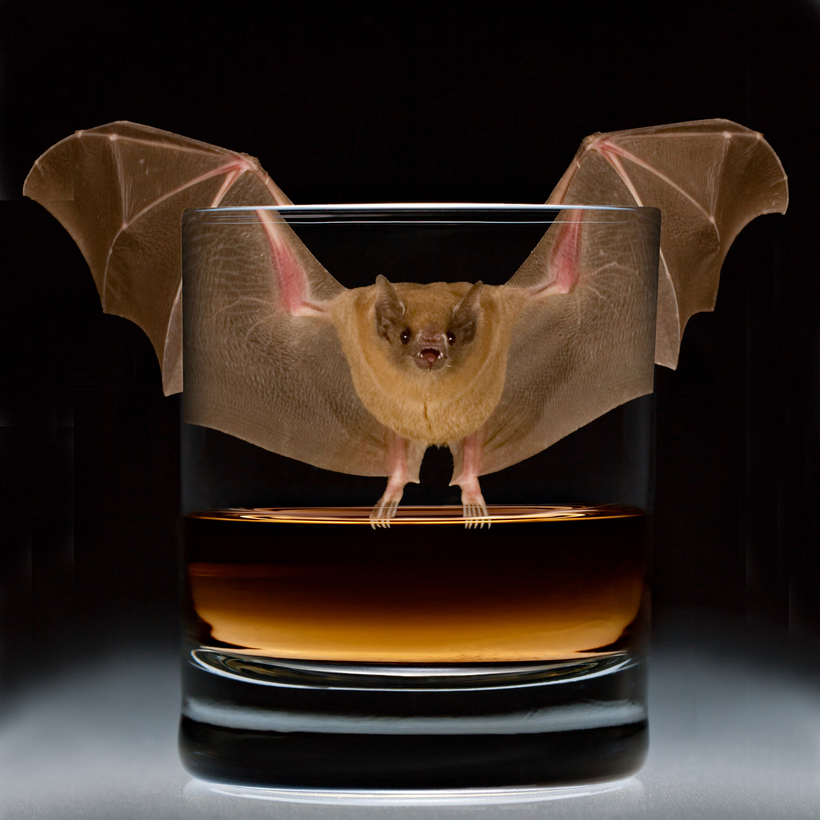Rodrigo Medellín and his team are instantly recognizable while traipsing through the agave fields of Mexico. A cap lamp on his shiny bald head, his tousled gray beard glinting in the light, he was leading the hunt for his favorite mammal, the bat.
He has such expertise in the animal that the National Autonomous University of Mexico professor is nicknamed “the Bat Man of Mexico.” But he was not here to capture a few specimens. Medellín and his team were trying to confirm the presence of bat catnip—batnip?—that lures them to these fields, the tall, Dr. Seuss–like flowers of the agave plant.
If Medellín and his team confirm that at least 5 percent of the field is allowed to flower, and check that resulting seeds are collected and germinated, they’ll vouchsafe the producer. Its tequila can be marketed as bat-friendly, with a hologram on every label provided by Medellín’s nonprofit organization. But this seemingly bizarre bolster is no empty gesture: it’s the first attempt to address dual, interconnected crises that threaten the future of the tequila industry itself.

Agave plants and bats have lived in symbiosis for millions of years. Agave is nocturnal, producing 90 percent of its floral nectar between 10 p.m. and midnight, priming it as the ideal food for bats. In return, those animals handle virtually the entire pollination process. Even better, bats are also wide-ranging, often flying 60 miles or more over the course of an evening. (A bee taps out at around a half-mile or so.) This pollination process ensures an optimal amount of genetic diversity in the seeds.
The issue, though, is that agave performs what’s known as “suicidal reproduction.” Each plant spends years stockpiling sugar as fuel, then uses it to shoot out one flower before dying. The tequila industry has been meddlesome to its eco-system. It snatches the agave plant—specifically, one type, Agave tequiliana, used in tequila production—just as it prepares to flower. This leaves no sustenance for bats, threatening their populations. Agave itself, though, can continue to flourish using a backup reproductive process: this time, an asexual one. It propagates hijuelos, the spider plant–like babies that will root as new plants.
There’s only one drawback to this: hijuelos are simply Xeroxes of their parent. On a small scale or for short periods of time, it’s not problematic, but the last century’s tequila boom has seen this method adopted as the default. A 2004 paper from the University of Mexico found that there were no more than 10 parents for 270 million plants. “We have clones of clones of clones that are, genetically speaking, exhausted, and their genetic diversity is almost nonexistent,” says David Suro-Piñera, who runs Siembra Azul, a tequila brand.
While the bats starve, the plants grow vulnerable to their own gene pool, like a horticultural version of inbred European royals. “They have less weight, are not as healthy, and they’re more susceptible to disease,” says fellow producer Carlos Camarena. Already, there’s one condition that’s proving worrisome as it spreads through the plant population. Dubbed tristeza y muerte de agave (sadness and death), it’s caused by a fungus and bacteria that already affects 40 percent of agave fields.
While the bats starve, the plants grow vulnerable to their own gene pool, like a horticultural version of inbred European royals.
Medellín was the first to flag these dual crises, and devised a solution for both. Allow 5 percent of any given field of agave to flower, he calculated, and then harvest and propagate those seeds. This would both strengthen the plant’s gene pool and keep bats from going hungry. (Mezcal, which can be made from various agave varietals, is less vulnerable for that very reason, although several producers have earned Medellín’s endorsement by leaving 3 percent of their fields to bloom.)
He proposed the idea 20 years ago but was rebuffed by the industry; it took another decade to convince a few forward-thinking producers, including Camarena and Suro-Piñera, to adopt the practice. As a result, in 2016, 300,000 or so bat-friendly bottles appeared under their labels, Tequila 8, Tesoro de Don Felipe, and Siembra Valles Ancestral. Although the industry appears to be more willing to embrace the sustainable switch, none of the best-known brands, such as Jose Cuervo and Casamigos, have signed on quite yet.
Even though agave prices are very volatile, the global demand for tequila is trending exclusively upward; Research and Market, a trend forecaster, estimates that the global market for it will reach $20 billion by 2028. “We’re optimistic this coming season there will be a lot of producers lined up and willing to do it,” says Suro-Piñera. “It’s getting a lot more feasible for a producer to consider becoming bat-friendly.”
Medellín puts it more simply. “To my very naïve perception, it’s a win-win. There’s really no other animal on earth more unfairly treated than bats. It has to become the standard of the industry.”
As he says, Mark Ellwood focuses on “froth in all its forms.” He is also a columnist for Bloomberg Pursuits, the creator and a co-host of Bloomberg’s Travel Genius podcast, and the author of Bargain Fever: How to Shop in a Discounted World


